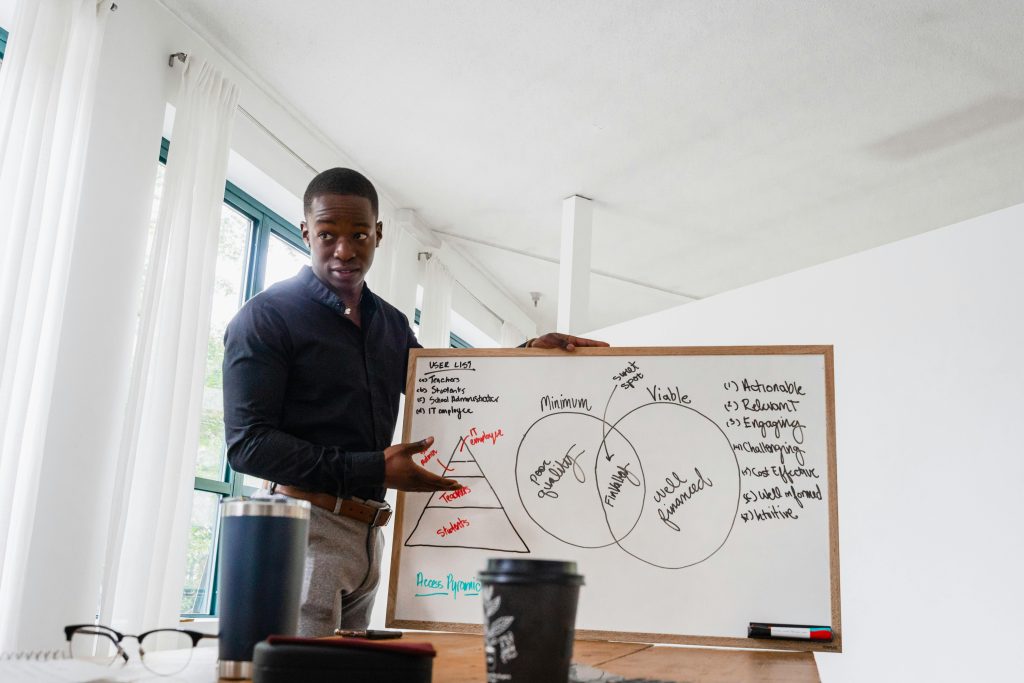Introduction
Whether you’re launching a new product, tackling a thorny business challenge, or simply looking to spark creativity within your team, an ideation workshop can be a powerful catalyst. When executed thoughtfully, these collaborative sessions move participants from divergent thinking—generating a breadth of ideas—to convergence—selecting, refining, and prioritizing the best concepts. In this detailed guide, we’ll cover everything you need to plan, facilitate, and follow up on an ideation workshop that leaves attendees energized, aligned, and brimming with actionable solutions.
1. Define the Workshop’s Objectives and Scope

A. Clarify Your Goals
- Identify the Core Challenge or Opportunity
- Example: “How might we reduce customer churn in our subscription service?”
- Be as specific as possible—vague goals lead to scattered ideas.
- Determine Success Metrics
- Output-based: “We need at least 50 distinct ideas.”
- Outcome-based: “We want three actionable pilot projects by month’s end.”
- Communicate these KPIs in advance so participants understand what success looks like.
- Align with Stakeholders
- Gather input from leadership, product owners, and marketing to ensure the workshop’s scope matches strategic priorities.
- Document any constraints (budget, timeline, technology dependencies) to keep ideation grounded.
B. Set Boundaries (Scope)
- Timeframe: Will you focus on next quarter, year, or a five-year roadmap?
- Audience Segment or Market: If you’re ideating new features, specify the target user segment (e.g., enterprise vs. SMB).
- Functional Areas: Are you exploring marketing tactics only, or also product features, customer support processes, and sales enablement?
By defining clear objectives and scope, you avoid “idea sprawl” and keep the group focused on solutions that matter.
2. Recruit the Right Participants
A. Ensure Cross-Functional Representation
- Primary Stakeholders: Product managers, marketing leads, designers, engineers, or customer service reps, depending on the challenge.
- Subject-Matter Experts: Bring in someone from data analytics if the ideation involves customer behavior insights, or a technical architect if the session involves complex integrations.
- Fresh Perspectives: Invite one or two participants outside the core team—e.g., sales reps, interns, or external partners—who can challenge assumptions and spark new thinking.
B. Ideal Group Size
- Aim for 8–12 participants for a half-day session.
- If you have more stakeholders, run parallel breakouts or facilitate multiple smaller workshops, then consolidate ideas in a debrief.
C. Pre-Workshop Questionnaire
- Send a short survey (3–5 questions) to gauge participants’ familiarity with the problem, existing solutions they’ve tried, and any preliminary ideas.
- Use responses to tailor empathy exercises or to group participants into balanced breakout teams (mix novices with veterans).
3. Plan Logistics and Materials

A. Choose the Right Venue and Time
- Location:
- A bright, open room with movable chairs and tables.
- If remote, ensure all participants have stable internet and access to your chosen collaboration platform (Zoom, Mural, Miro).
- Duration and Agenda:
- Half-Day Workshop (3–4 hours): Ideal for deep dives without fatigue.
- Full-Day Workshop (6–8 hours): Use only if the challenge is very multifaceted.
- Sample Agenda (4 hours):
- Introduction & Icebreaker (15 min)
- Problem Framing / Empathy Mapping (30 min)
- Divergent Brainstorming (45 min)
- Short Break (10 min)
- Convergent Prioritization (45 min)
- Prototyping / Concept Sketching (45 min)
- Lunch Break (30 min)
- Presentation & Feedback (45 min)
- Next Steps and Wrap-Up (15 min)
B. Essential Materials
- Physical Workshops:
- Sticky notes in multiple colors
- Sharpies, pens, highlighters
- Large whiteboards or flip charts
- Velcro or magnets to display ideas on walls
- Pre-printed worksheets (empathy maps, idea templates, prioritization matrices)
- Virtual Workshops:
- Digital whiteboarding tool (Miro, Mural, or FigJam)
- Shared Google Slides or Jamboard for collaborative note-taking
- Polling/quizzing tool (Mentimeter, Slido) for quick decision-making
- Pre-configured boards: empathy map template, brainstorm canvas, prioritization grid
4. Prepare the Workshop Framework
A. Set the Context (Problem Framing)
- Kickoff Presentation:
- Background Data: Provide a concise slide deck with key metrics (e.g., customer retention rates, user feedback themes).
- User Insights: Share quotes or short video clips from customer interviews to humanize the challenge.
- Empathy Mapping Exercise (Optional):
- Break participants into pairs. Each pair fills out an empathy map (says, thinks, does, feels) for a target user persona.
- Goal: Build shared understanding and customer-centric focus before ideation.
B. Define Ideation Techniques
- Brainwriting (Silent Brainstorming):
- Each participant writes 3–5 ideas on sticky notes or a shared digital board in 5–7 minutes without speaking.
- Rotate notes every 2 minutes for others to build on or add new ideas.
- Eliminates anchoring bias that can occur with vocal brainstormers.
- SCAMPER Method:
- S: Substitute (What if we replace X with Y?)
- C: Combine (What if we merge A and B?)
- A: Adapt (What if we adjust X’s function?)
- M: Modify/Magnify (What if we enhance X’s feature?)
- P: Put to Another Use (How else could we use X?)
- E: Eliminate (What if we remove X entirely?)
- R: Reverse (What if we flip X around?)
- Use SCAMPER prompts to systematically trigger new angles.
- Round-Robin Pitch:
- Each participant shares one idea in 30 seconds round-robin style.
- Continue until ideas dwindle—encourages equal airtime and avoids “group think.”
- Crazy 8s Sketching (for UX/Product Workshops):
- Participants fold an A4 sheet into eight panels.
- In 8 minutes, sketch eight rapid concepts—ideal for visualizing solutions without overthinking.
5. Facilitate the Ideation Workshop

A. Establish Ground Rules
- Defer Judgment: All ideas are welcome—no criticism during brainstorming.
- Encourage Wild Ideas: The wilder, the better; innovation often hides in extreme concepts.
- One Conversation at a Time: Honor the speaker, reduce cross-talk.
- Stay Focused on the Topic: Use a “parking lot” flipchart for ideas that are off-topic but worth revisiting.
B. Kickoff and Warm-Up (15–20 Minutes)
- Welcome & Introductions: Quick round of names and roles (if participants don’t know each other).
- Icebreaker: A 2-minute prompt, e.g., “Name a non-digital tool you can’t live without.” Gets creative juices flowing.
- Context Presentation: 5-minute slide deck summarizing the problem, customer pain points, and success metrics.
C. Divergent Thinking Phase (45–60 Minutes)
- Brainwriting Round (10–15 min): Participants generate ideas silently on sticky notes or digital cards.
- Group Brainstorm (20–30 min):
- Use SCAMPER prompts in small breakout teams or as a full group.
- Encourage participants to build on each other’s ideas: “Yes, and…” rather than “Yes, but…”
- Idea Sharing and Clustering (10–15 min):
- Post all ideas on the wall or digital board.
- Facilitator leads a quick dot-voting exercise (each person has 3–5 dots) to identify standout concepts for further exploration.
D. Convergent Thinking Phase (45–60 Minutes)
- Affinity Mapping:
- Group similar ideas into themes or categories (e.g., “improving onboarding,” “enhancing support,” “new pricing models”).
- This helps reveal larger patterns and high-potential clusters.
- Prioritization Matrix:
- Use a 2×2 grid (e.g., Impact vs. Effort or Feasibility vs. Desirability).
- Each idea gets placed on the grid—focus on “high impact, low effort” first.
- Concept Refinement:
- For top 3–5 ideas, ask each group to flesh out:
- Target User: Who benefits most?
- Value Proposition: What problem does it solve?
- Implementation Considerations: Rough success criteria, required resources, and potential roadblocks.
- For top 3–5 ideas, ask each group to flesh out:
E. Prototyping and Feedback (Optional, 30–45 Minutes)
- Low-Fidelity Sketches or Storyboards: Participants quickly sketch user flows or wireframes to visualize top concepts.
- Lightning Presentations: Each group presents their refined concept in 3–5 minutes.
- Rapid Feedback: Other participants use “Keep, Kill, Change” sticky notes to offer quick feedback.
- Iteration: Allow 5–10 minutes for teams to adjust their concept based on feedback.
6. Manage Group Dynamics and Maintain Momentum
A. Rotate Facilitators or Roles
- Assign a dedicated facilitator to keep time, moderate discussions, and enforce ground rules.
- A scribe/note-taker captures ideas, decisions, and action items.
- A timekeeper tracks each exercise’s allotted time, giving gentle reminders.
B. Handle Dominant vs. Quiet Participants
- Dominant Speakers: Redirect overly talkative attendees by saying, “Thanks—that’s a great point. Let’s hear from someone who hasn’t spoken yet.”
- Quiet Participants: Use round-robin check-ins: “Alex hasn’t had a chance to share—any thoughts on this idea?”
- Breakout Groups: Smaller teams often help quieter participants open up. Rotate groups midway through the session to mix perspectives.
C. Use Energizers for Lulls
- Think-Pair-Share: If engagement dips, pause for 2 minutes of silent idea generation, then have pairs share, then share with the whole group.
- Trivia or Stretch Break: After intensive brainstorming, do a quick pop quiz (“Name a famous innovator in our industry”) or a 2-minute stretch to reset energy.
7. Synthesize and Follow Up After the Workshop

A. Immediate Debrief (Within 1–2 Hours)
- Facilitator & Scribe Huddle: Review captured ideas and groupings.
- Categorize Outputs:
- Top Concepts for Pilot: 3–5 ideas that scored highest in prioritization.
- Secondary Concepts: Good ideas that require more research.
- Parking Lot: Off-topic or long-term ideas.
- Draft a Quick Summary: Create a one-page recap highlighting:
- Workshop objectives and participants
- Key insights and top concepts
- Next steps and assigned owners
B. Distribute a Written Report (Within 24–48 Hours)
- Include photos of physical whiteboards or export of digital boards.
- Attach any prototypes, sketches, or affinity maps.
- Clearly state action items, deadlines, and responsible team members (e.g., “Marketing to draft a pilot plan for Concept A by next Friday”).
- Encourage feedback: Send a short survey or poll asking, “Do the top concepts resonate? Any items we missed?”
C. Plan Follow-Up Sessions and Pilots
- Assign Owners: Each top concept needs a champion to develop a one-page brief—scope, resources, timeline, expected ROI.
- Set Milestones:
- Week 1: Prototype validation with a small user group or internal demo.
- Week 2–3: Collect feedback, refine concept.
- Week 4: Decide whether to pilot or pivot.
- Schedule Check-Ins:
- Weekly 15-minute syncs with concept owners.
- Monthly retrospective to review pilot results and learnings.
8. Common Pitfalls and How to Avoid Them
| Pitfall | Impact | Solution |
|---|---|---|
| Vague Objectives | Leads to scattered ideas, no actionable outcomes | Define one clear challenge, share success criteria in advance. |
| Lack of Preparation | Wastes time gathering data mid-session | Provide participants with pre-reading materials (customer interviews, market research) a day before. |
| Ineffective Facilitation | Dominant voices overshadow quieter ones, time overruns | Assign a neutral facilitator, use timekeeper, enforce ground rules (defer judgment, one conversation). |
| Overemphasis on Quantity, Not Quality | Hundreds of low-value ideas, difficult to prioritize | Use structured methods (SCAMPER, prioritization matrix) to focus on quality, not just volume. |
| No Follow-Up or Ownership | Great ideas die after the workshop | Assign action owners and deadlines; draft a summary report within 24 hours. |
| Groupthink | Participants converge on safe ideas too early | Encourage wild ideas, use brainwriting to generate diverse input before group discussion. |
Conclusion
An effective ideation workshop balances structure with creative freedom, guiding participants from understanding a problem to generating and refining breakthrough solutions. By clearly defining objectives, recruiting a diverse group, designing a focused agenda, and using proven ideation techniques (brainwriting, SCAMPER, prioritization matrices), you’ll maximize both the quantity and quality of ideas. Thoughtful facilitation, attention to group dynamics, and immediate post-workshop synthesis ensure that promising concepts move from sticky notes into pilots and, ultimately, actionable projects. Use this step-by-step framework to transform brainstorming sessions into transformative innovation engines that deliver real business impact.
